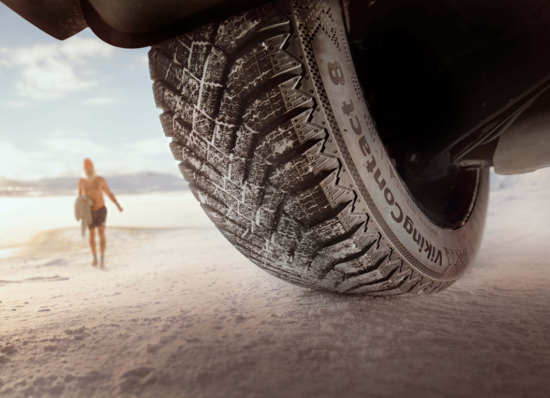Nordic focus for Continental’s latest winter tyre
 Designed for Nordic winters – VikingContact 8 (Photo: Continental)
Designed for Nordic winters – VikingContact 8 (Photo: Continental)
Continental has debuted a new soft compound winter tyre for those who drive in the frostier regions of Europe. This is the Continental VikingContact 8, and during its development the tyre maker focused on “safe driving characteristics in the harsh Nordic winters, increased comfort and lower rolling resistance.” This last quality is important, given the strong uptake of electric cars in Nordic markets. According to Continental, VikingContact 8 is “ideally suited to both conventionally and electrically powered cars, SUVs and hybrids.”
The tread design is an evolution of the predecessor’s pattern. Continental designed the directional tread with its symmetrical grooves to quickly drain water and slush from the contact patch, while gripping block edges dig into the winter road surface. This allows a safe transfer of braking and acceleration forces, even when driving on snowy and icy surfaces. The 3D sipes and bridges between individual tread blocks stabilise the tread when cornering on wet and dry roads, keeping grooves open for rapid water drainage.
In addition to the tread blocks’ gripping edges, Continental views sipes as the “best guarantee for high grip on winter roads.” For the VikingContact 8, the engineering team has developed a three-layer sipe that combines a straight, a zigzag and a wave sipe and positioned each behind the other in the tyre’s shoulder tread blocks. The straight sipe on the outside of the block provides stability for good handling on dry roads. The zigzag sipes form the transition to the typical wavy winter tyre sipes that increase grip on a range of surfaces, including wet roads. Continental gave the classic wave sipes the maximum edge length for snow grip.
Compound & construction
A new tread compound “enables maximum flexibility even at the lowest temperatures,” which is one of the basic prerequisites for secure grip and high traction on snow and ice. Together with the new tread design, the compound reduces tyre deformation, in turn reducing energy loss and lowering rolling resistance.
In addition, Continental says it based the tyre’s construction upon its “latest research findings,” and as such made the main body of the tyre and its inner liner from materials that reduce the internal friction between tyre components, further contributing to lower rolling resistance. In combination, these features reduce fuel consumption in conventionally powered cars and increase the range of electric vehicles.
Low noise pattern
Furthermore, Continental says the new tread design with its lateral grooves, contact patch and flexible tyre compound significantly reduces tyre-related road noise. This leads to greater driving comfort and less noise emitted into the environment. Passengers in electric vehicles in particular benefit from this, as tyre noise is generally perceived much more strongly due to the lack of engine noise.
Continental comments that “the significant noise reduction with the new VikingContact 8 compared to the previous model is plain to see” when looking at the tyre’s top-level EU tyre label A rating. The label rating for rolling resistance is A or B, depending on tyre size, and a value of D for wet grip. In addition, it bears the ice symbol to denote safe driving characteristics in the Nordic winter.




Comments